MGMT-6100: Integrated Project Delivery Application Report and Analysis
VerifiedAdded on 2023/05/30
|20
|5816
|296
Report
AI Summary
This report provides a comprehensive analysis of Integrated Project Delivery (IPD) in the Architecture, Engineering, and Construction (AEC) sector. It begins with an executive summary outlining the core concepts and benefits of IPD, including cost reduction, time efficiency, and collaborative teamwork. The report then explores the strengths and weaknesses of IPD for various stakeholders, such as owners, architects, and contractors, detailing advantages like shared information, improved design quality, and increased profits, while also acknowledging potential drawbacks like unfamiliarity with the process and challenges in decision-making. The report further examines the adoption of IPD in Canada, highlighting successful projects like the Mosaic Center and the Moose Jaw Hospital, and discusses the relationship between Building Information Modeling (BIM) and IPD, emphasizing their collaborative potential for optimized project outcomes and waste reduction. Finally, the report provides a project feasibility assessment based on the assignment brief provided.

Running head: INTEGRATED PROJECT DELIVERY APPLICATION 1
Integrated Project Delivery Application
Name
Institution Affiliation
Integrated Project Delivery Application
Name
Institution Affiliation
Paraphrase This Document
Need a fresh take? Get an instant paraphrase of this document with our AI Paraphraser
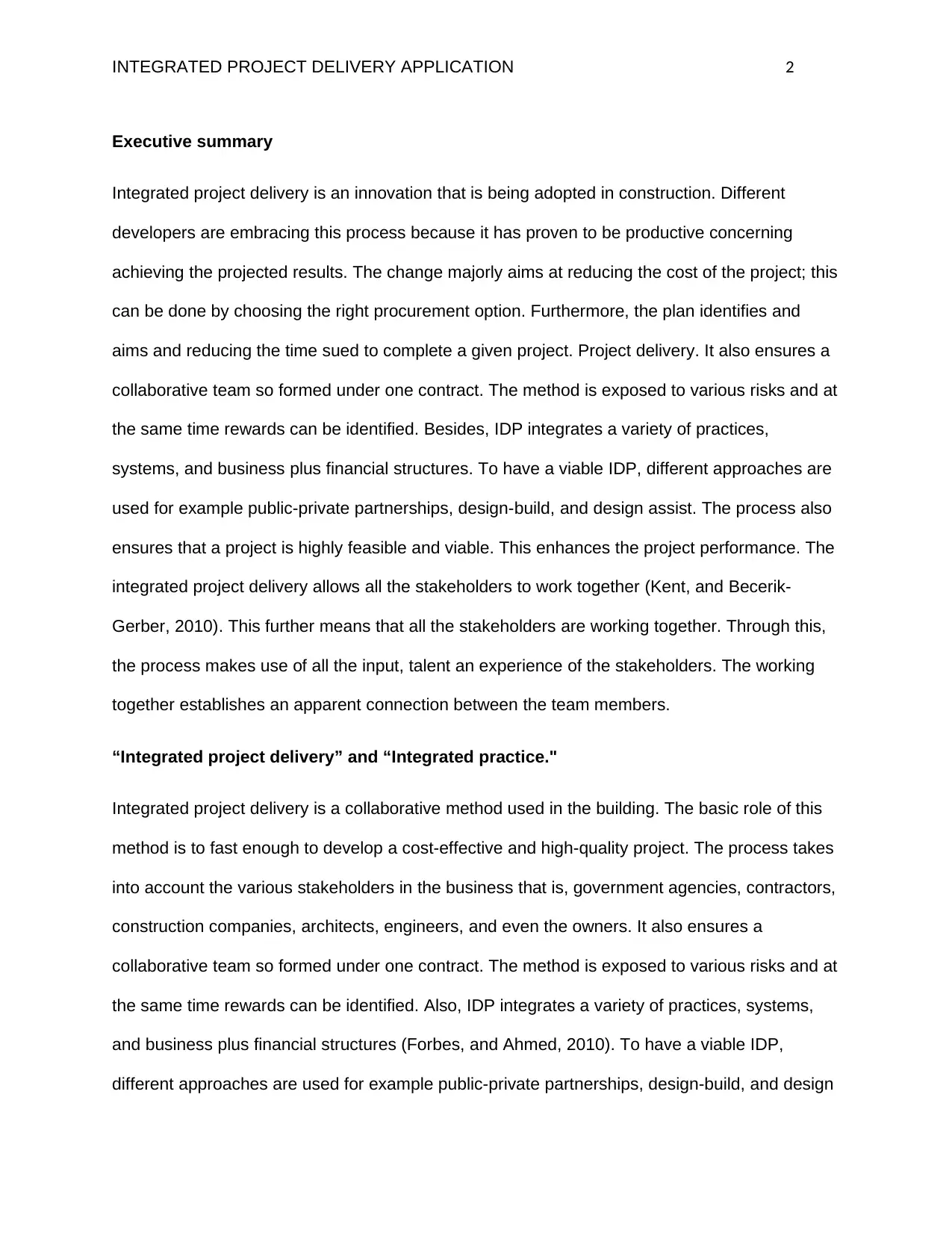
INTEGRATED PROJECT DELIVERY APPLICATION 2
Executive summary
Integrated project delivery is an innovation that is being adopted in construction. Different
developers are embracing this process because it has proven to be productive concerning
achieving the projected results. The change majorly aims at reducing the cost of the project; this
can be done by choosing the right procurement option. Furthermore, the plan identifies and
aims and reducing the time sued to complete a given project. Project delivery. It also ensures a
collaborative team so formed under one contract. The method is exposed to various risks and at
the same time rewards can be identified. Besides, IDP integrates a variety of practices,
systems, and business plus financial structures. To have a viable IDP, different approaches are
used for example public-private partnerships, design-build, and design assist. The process also
ensures that a project is highly feasible and viable. This enhances the project performance. The
integrated project delivery allows all the stakeholders to work together (Kent, and Becerik-
Gerber, 2010). This further means that all the stakeholders are working together. Through this,
the process makes use of all the input, talent an experience of the stakeholders. The working
together establishes an apparent connection between the team members.
“Integrated project delivery” and “Integrated practice."
Integrated project delivery is a collaborative method used in the building. The basic role of this
method is to fast enough to develop a cost-effective and high-quality project. The process takes
into account the various stakeholders in the business that is, government agencies, contractors,
construction companies, architects, engineers, and even the owners. It also ensures a
collaborative team so formed under one contract. The method is exposed to various risks and at
the same time rewards can be identified. Also, IDP integrates a variety of practices, systems,
and business plus financial structures (Forbes, and Ahmed, 2010). To have a viable IDP,
different approaches are used for example public-private partnerships, design-build, and design
Executive summary
Integrated project delivery is an innovation that is being adopted in construction. Different
developers are embracing this process because it has proven to be productive concerning
achieving the projected results. The change majorly aims at reducing the cost of the project; this
can be done by choosing the right procurement option. Furthermore, the plan identifies and
aims and reducing the time sued to complete a given project. Project delivery. It also ensures a
collaborative team so formed under one contract. The method is exposed to various risks and at
the same time rewards can be identified. Besides, IDP integrates a variety of practices,
systems, and business plus financial structures. To have a viable IDP, different approaches are
used for example public-private partnerships, design-build, and design assist. The process also
ensures that a project is highly feasible and viable. This enhances the project performance. The
integrated project delivery allows all the stakeholders to work together (Kent, and Becerik-
Gerber, 2010). This further means that all the stakeholders are working together. Through this,
the process makes use of all the input, talent an experience of the stakeholders. The working
together establishes an apparent connection between the team members.
“Integrated project delivery” and “Integrated practice."
Integrated project delivery is a collaborative method used in the building. The basic role of this
method is to fast enough to develop a cost-effective and high-quality project. The process takes
into account the various stakeholders in the business that is, government agencies, contractors,
construction companies, architects, engineers, and even the owners. It also ensures a
collaborative team so formed under one contract. The method is exposed to various risks and at
the same time rewards can be identified. Also, IDP integrates a variety of practices, systems,
and business plus financial structures (Forbes, and Ahmed, 2010). To have a viable IDP,
different approaches are used for example public-private partnerships, design-build, and design
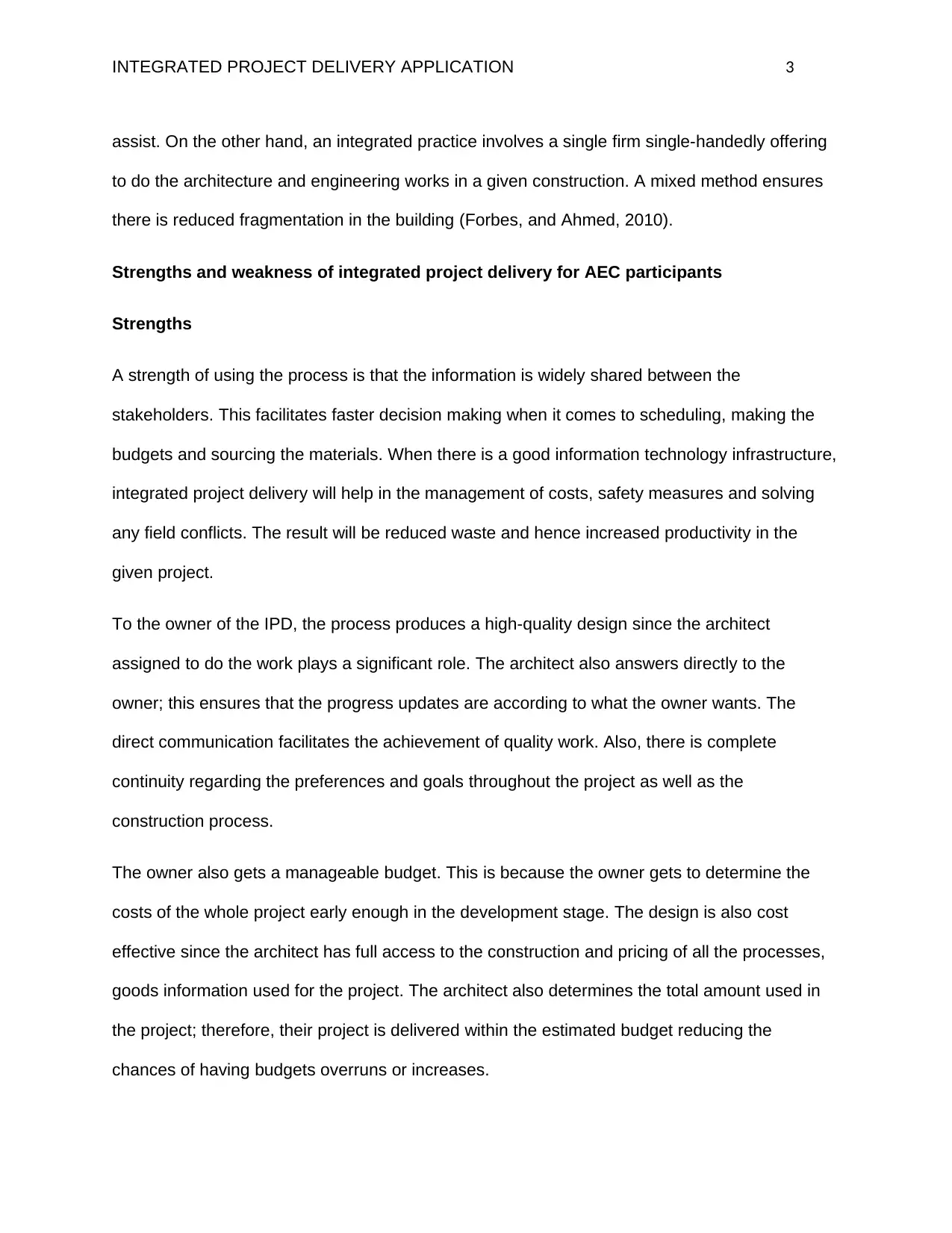
INTEGRATED PROJECT DELIVERY APPLICATION 3
assist. On the other hand, an integrated practice involves a single firm single-handedly offering
to do the architecture and engineering works in a given construction. A mixed method ensures
there is reduced fragmentation in the building (Forbes, and Ahmed, 2010).
Strengths and weakness of integrated project delivery for AEC participants
Strengths
A strength of using the process is that the information is widely shared between the
stakeholders. This facilitates faster decision making when it comes to scheduling, making the
budgets and sourcing the materials. When there is a good information technology infrastructure,
integrated project delivery will help in the management of costs, safety measures and solving
any field conflicts. The result will be reduced waste and hence increased productivity in the
given project.
To the owner of the IPD, the process produces a high-quality design since the architect
assigned to do the work plays a significant role. The architect also answers directly to the
owner; this ensures that the progress updates are according to what the owner wants. The
direct communication facilitates the achievement of quality work. Also, there is complete
continuity regarding the preferences and goals throughout the project as well as the
construction process.
The owner also gets a manageable budget. This is because the owner gets to determine the
costs of the whole project early enough in the development stage. The design is also cost
effective since the architect has full access to the construction and pricing of all the processes,
goods information used for the project. The architect also determines the total amount used in
the project; therefore, their project is delivered within the estimated budget reducing the
chances of having budgets overruns or increases.
assist. On the other hand, an integrated practice involves a single firm single-handedly offering
to do the architecture and engineering works in a given construction. A mixed method ensures
there is reduced fragmentation in the building (Forbes, and Ahmed, 2010).
Strengths and weakness of integrated project delivery for AEC participants
Strengths
A strength of using the process is that the information is widely shared between the
stakeholders. This facilitates faster decision making when it comes to scheduling, making the
budgets and sourcing the materials. When there is a good information technology infrastructure,
integrated project delivery will help in the management of costs, safety measures and solving
any field conflicts. The result will be reduced waste and hence increased productivity in the
given project.
To the owner of the IPD, the process produces a high-quality design since the architect
assigned to do the work plays a significant role. The architect also answers directly to the
owner; this ensures that the progress updates are according to what the owner wants. The
direct communication facilitates the achievement of quality work. Also, there is complete
continuity regarding the preferences and goals throughout the project as well as the
construction process.
The owner also gets a manageable budget. This is because the owner gets to determine the
costs of the whole project early enough in the development stage. The design is also cost
effective since the architect has full access to the construction and pricing of all the processes,
goods information used for the project. The architect also determines the total amount used in
the project; therefore, their project is delivered within the estimated budget reducing the
chances of having budgets overruns or increases.
⊘ This is a preview!⊘
Do you want full access?
Subscribe today to unlock all pages.

Trusted by 1+ million students worldwide

INTEGRATED PROJECT DELIVERY APPLICATION 4
The owner also gets to enjoy flexibility in the procurement of all the construction materials that
need to be used in the project. This is because the owner can begin the project just traditionally
and then incorporate the integrated delivery later. There is also no need of maintaining
cumbersome bidding or the RFP process. The owner can adopt the open books used for trades.
Also, the project delivery is faster since it is fast-tracking without the possibility of having loss of
cost control.
To the architect, there are additional profits realized. This is because there is the possibility of
sharing in the project savings. There is also increased efficiency in the design since there is less
labor cost incurred during the construction documents phase. The architect also gets a share in
the construction revenue.
The architect also gets the marketing advantages. This includes the ability to guarantee the
schedule and price of construction. He also offers the option to delay the project structuring
design. The architect can also be able to cultivate the contractors as a source of work.
Furthermore, the architect can promise the maximum owner efficiency and deliver since he is
directly involved in the project.
Another strength of using IPD at AEC for the architect is that they have control over the
construction process. This way, they can be able to avoid unwise decisions during the
construction work. The architect can also be able to minimize lousy publicity after experiencing
design problems. The architect also accepts the entire responsibility of the project; therefore,
there is increased satisfaction for all the participants.
The architect also gets reduced liability. Since the architect is fully involved in the design of the
project, the claims for obvious design omissions are reduced. Complaints can also be reduced
due to the collaborations and cooperatives used rather than having administration adversarial.
The owner also gets to enjoy flexibility in the procurement of all the construction materials that
need to be used in the project. This is because the owner can begin the project just traditionally
and then incorporate the integrated delivery later. There is also no need of maintaining
cumbersome bidding or the RFP process. The owner can adopt the open books used for trades.
Also, the project delivery is faster since it is fast-tracking without the possibility of having loss of
cost control.
To the architect, there are additional profits realized. This is because there is the possibility of
sharing in the project savings. There is also increased efficiency in the design since there is less
labor cost incurred during the construction documents phase. The architect also gets a share in
the construction revenue.
The architect also gets the marketing advantages. This includes the ability to guarantee the
schedule and price of construction. He also offers the option to delay the project structuring
design. The architect can also be able to cultivate the contractors as a source of work.
Furthermore, the architect can promise the maximum owner efficiency and deliver since he is
directly involved in the project.
Another strength of using IPD at AEC for the architect is that they have control over the
construction process. This way, they can be able to avoid unwise decisions during the
construction work. The architect can also be able to minimize lousy publicity after experiencing
design problems. The architect also accepts the entire responsibility of the project; therefore,
there is increased satisfaction for all the participants.
The architect also gets reduced liability. Since the architect is fully involved in the design of the
project, the claims for obvious design omissions are reduced. Complaints can also be reduced
due to the collaborations and cooperatives used rather than having administration adversarial.
Paraphrase This Document
Need a fresh take? Get an instant paraphrase of this document with our AI Paraphraser
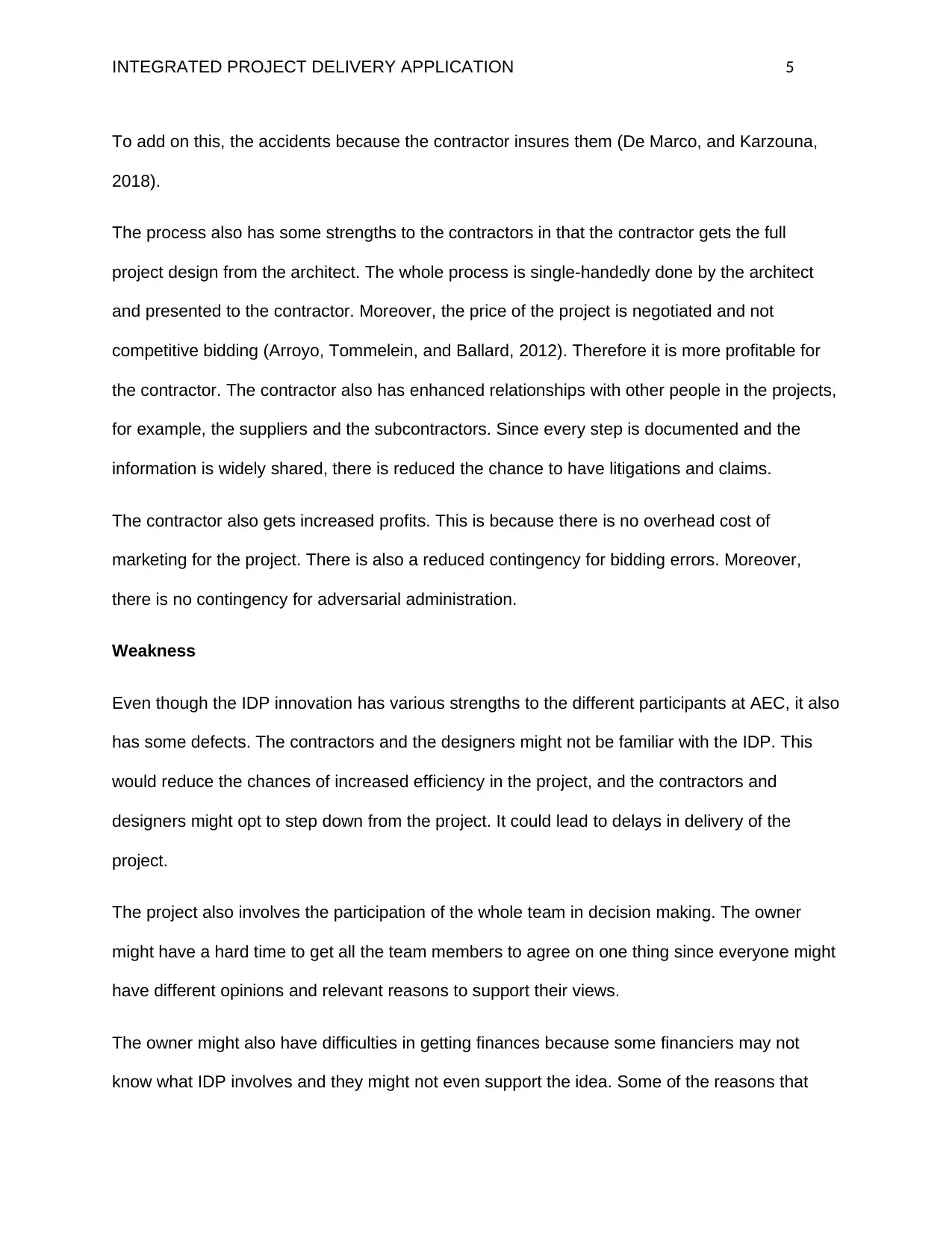
INTEGRATED PROJECT DELIVERY APPLICATION 5
To add on this, the accidents because the contractor insures them (De Marco, and Karzouna,
2018).
The process also has some strengths to the contractors in that the contractor gets the full
project design from the architect. The whole process is single-handedly done by the architect
and presented to the contractor. Moreover, the price of the project is negotiated and not
competitive bidding (Arroyo, Tommelein, and Ballard, 2012). Therefore it is more profitable for
the contractor. The contractor also has enhanced relationships with other people in the projects,
for example, the suppliers and the subcontractors. Since every step is documented and the
information is widely shared, there is reduced the chance to have litigations and claims.
The contractor also gets increased profits. This is because there is no overhead cost of
marketing for the project. There is also a reduced contingency for bidding errors. Moreover,
there is no contingency for adversarial administration.
Weakness
Even though the IDP innovation has various strengths to the different participants at AEC, it also
has some defects. The contractors and the designers might not be familiar with the IDP. This
would reduce the chances of increased efficiency in the project, and the contractors and
designers might opt to step down from the project. It could lead to delays in delivery of the
project.
The project also involves the participation of the whole team in decision making. The owner
might have a hard time to get all the team members to agree on one thing since everyone might
have different opinions and relevant reasons to support their views.
The owner might also have difficulties in getting finances because some financiers may not
know what IDP involves and they might not even support the idea. Some of the reasons that
To add on this, the accidents because the contractor insures them (De Marco, and Karzouna,
2018).
The process also has some strengths to the contractors in that the contractor gets the full
project design from the architect. The whole process is single-handedly done by the architect
and presented to the contractor. Moreover, the price of the project is negotiated and not
competitive bidding (Arroyo, Tommelein, and Ballard, 2012). Therefore it is more profitable for
the contractor. The contractor also has enhanced relationships with other people in the projects,
for example, the suppliers and the subcontractors. Since every step is documented and the
information is widely shared, there is reduced the chance to have litigations and claims.
The contractor also gets increased profits. This is because there is no overhead cost of
marketing for the project. There is also a reduced contingency for bidding errors. Moreover,
there is no contingency for adversarial administration.
Weakness
Even though the IDP innovation has various strengths to the different participants at AEC, it also
has some defects. The contractors and the designers might not be familiar with the IDP. This
would reduce the chances of increased efficiency in the project, and the contractors and
designers might opt to step down from the project. It could lead to delays in delivery of the
project.
The project also involves the participation of the whole team in decision making. The owner
might have a hard time to get all the team members to agree on one thing since everyone might
have different opinions and relevant reasons to support their views.
The owner might also have difficulties in getting finances because some financiers may not
know what IDP involves and they might not even support the idea. Some of the reasons that
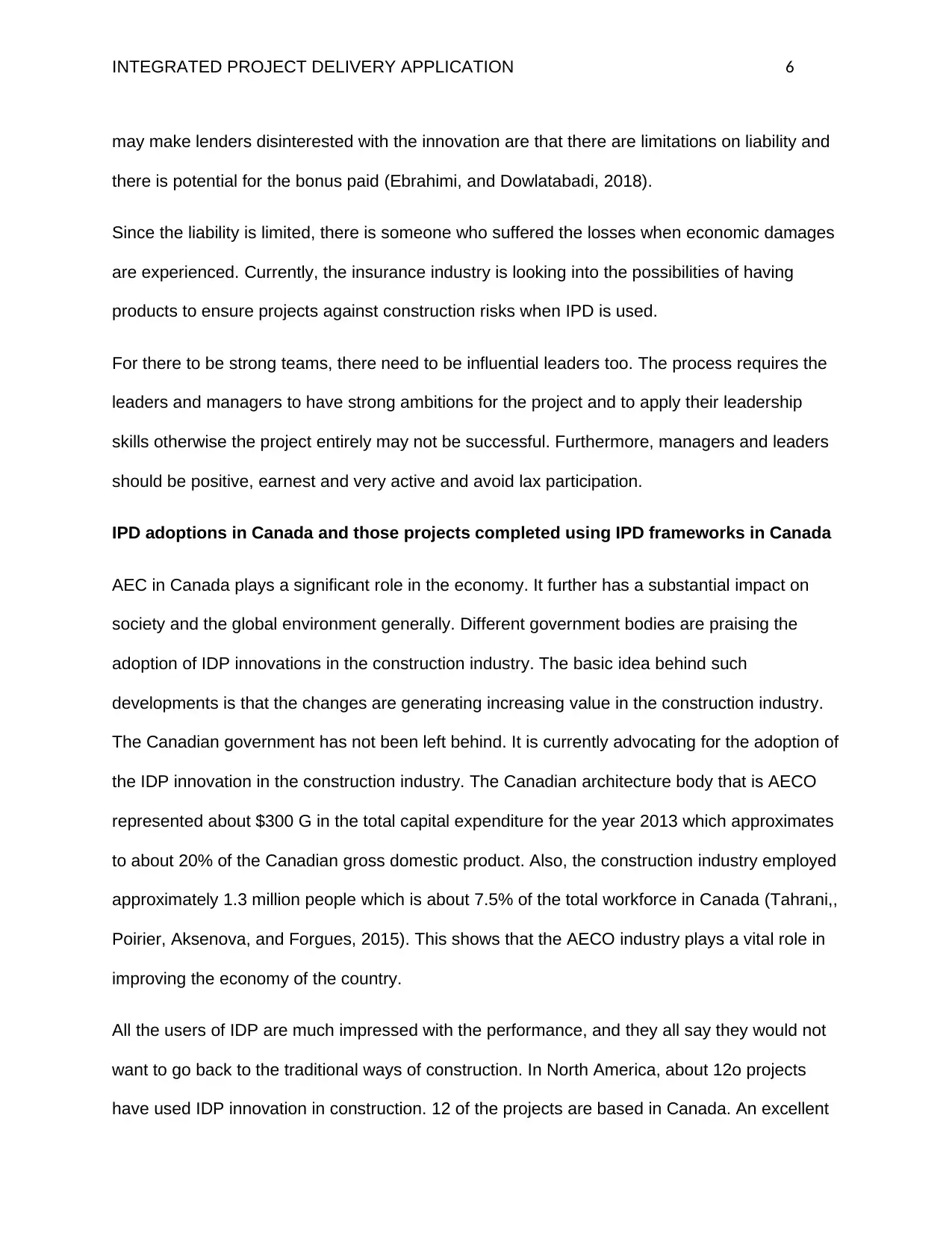
INTEGRATED PROJECT DELIVERY APPLICATION 6
may make lenders disinterested with the innovation are that there are limitations on liability and
there is potential for the bonus paid (Ebrahimi, and Dowlatabadi, 2018).
Since the liability is limited, there is someone who suffered the losses when economic damages
are experienced. Currently, the insurance industry is looking into the possibilities of having
products to ensure projects against construction risks when IPD is used.
For there to be strong teams, there need to be influential leaders too. The process requires the
leaders and managers to have strong ambitions for the project and to apply their leadership
skills otherwise the project entirely may not be successful. Furthermore, managers and leaders
should be positive, earnest and very active and avoid lax participation.
IPD adoptions in Canada and those projects completed using IPD frameworks in Canada
AEC in Canada plays a significant role in the economy. It further has a substantial impact on
society and the global environment generally. Different government bodies are praising the
adoption of IDP innovations in the construction industry. The basic idea behind such
developments is that the changes are generating increasing value in the construction industry.
The Canadian government has not been left behind. It is currently advocating for the adoption of
the IDP innovation in the construction industry. The Canadian architecture body that is AECO
represented about $300 G in the total capital expenditure for the year 2013 which approximates
to about 20% of the Canadian gross domestic product. Also, the construction industry employed
approximately 1.3 million people which is about 7.5% of the total workforce in Canada (Tahrani,,
Poirier, Aksenova, and Forgues, 2015). This shows that the AECO industry plays a vital role in
improving the economy of the country.
All the users of IDP are much impressed with the performance, and they all say they would not
want to go back to the traditional ways of construction. In North America, about 12o projects
have used IDP innovation in construction. 12 of the projects are based in Canada. An excellent
may make lenders disinterested with the innovation are that there are limitations on liability and
there is potential for the bonus paid (Ebrahimi, and Dowlatabadi, 2018).
Since the liability is limited, there is someone who suffered the losses when economic damages
are experienced. Currently, the insurance industry is looking into the possibilities of having
products to ensure projects against construction risks when IPD is used.
For there to be strong teams, there need to be influential leaders too. The process requires the
leaders and managers to have strong ambitions for the project and to apply their leadership
skills otherwise the project entirely may not be successful. Furthermore, managers and leaders
should be positive, earnest and very active and avoid lax participation.
IPD adoptions in Canada and those projects completed using IPD frameworks in Canada
AEC in Canada plays a significant role in the economy. It further has a substantial impact on
society and the global environment generally. Different government bodies are praising the
adoption of IDP innovations in the construction industry. The basic idea behind such
developments is that the changes are generating increasing value in the construction industry.
The Canadian government has not been left behind. It is currently advocating for the adoption of
the IDP innovation in the construction industry. The Canadian architecture body that is AECO
represented about $300 G in the total capital expenditure for the year 2013 which approximates
to about 20% of the Canadian gross domestic product. Also, the construction industry employed
approximately 1.3 million people which is about 7.5% of the total workforce in Canada (Tahrani,,
Poirier, Aksenova, and Forgues, 2015). This shows that the AECO industry plays a vital role in
improving the economy of the country.
All the users of IDP are much impressed with the performance, and they all say they would not
want to go back to the traditional ways of construction. In North America, about 12o projects
have used IDP innovation in construction. 12 of the projects are based in Canada. An excellent
⊘ This is a preview!⊘
Do you want full access?
Subscribe today to unlock all pages.

Trusted by 1+ million students worldwide
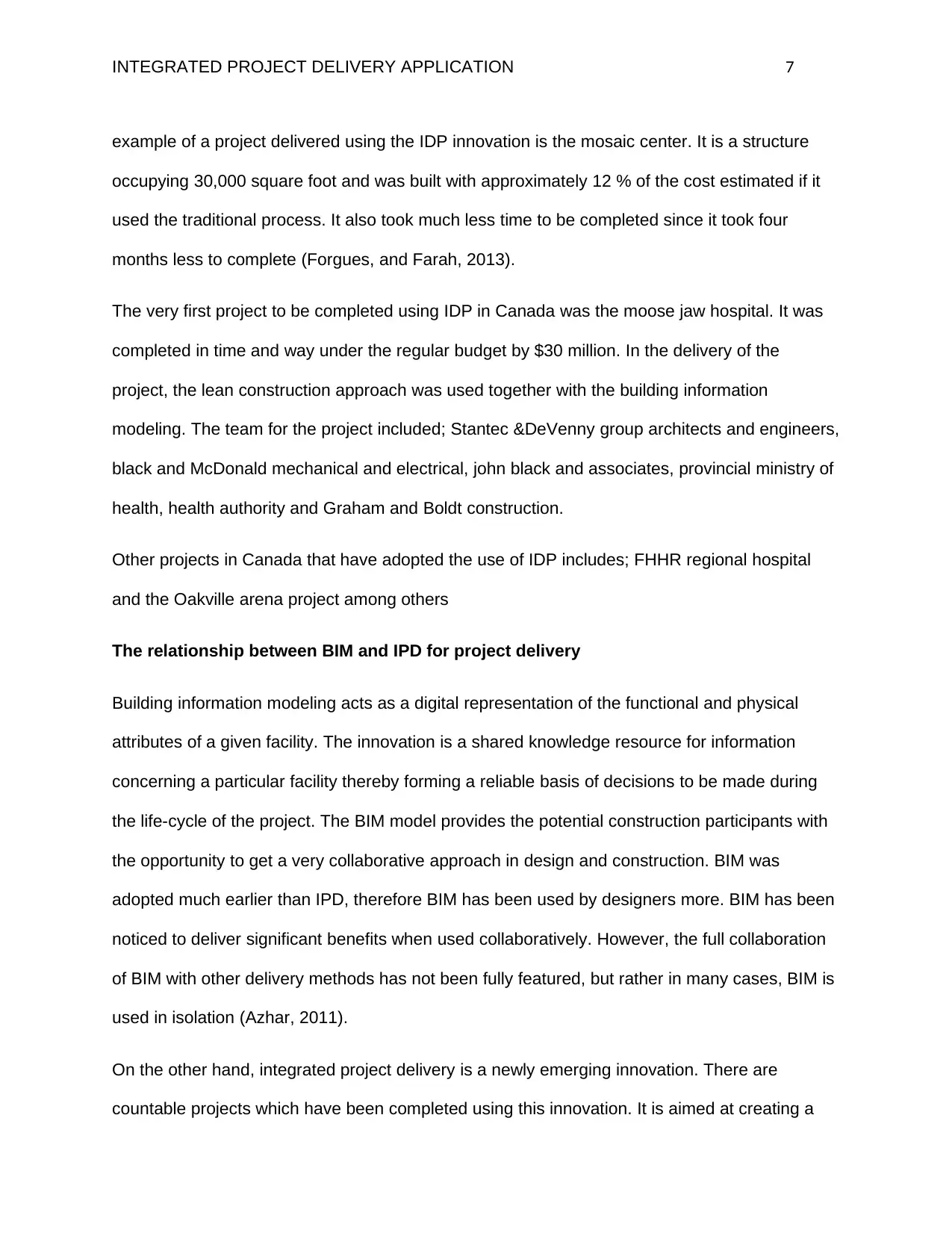
INTEGRATED PROJECT DELIVERY APPLICATION 7
example of a project delivered using the IDP innovation is the mosaic center. It is a structure
occupying 30,000 square foot and was built with approximately 12 % of the cost estimated if it
used the traditional process. It also took much less time to be completed since it took four
months less to complete (Forgues, and Farah, 2013).
The very first project to be completed using IDP in Canada was the moose jaw hospital. It was
completed in time and way under the regular budget by $30 million. In the delivery of the
project, the lean construction approach was used together with the building information
modeling. The team for the project included; Stantec &DeVenny group architects and engineers,
black and McDonald mechanical and electrical, john black and associates, provincial ministry of
health, health authority and Graham and Boldt construction.
Other projects in Canada that have adopted the use of IDP includes; FHHR regional hospital
and the Oakville arena project among others
The relationship between BIM and IPD for project delivery
Building information modeling acts as a digital representation of the functional and physical
attributes of a given facility. The innovation is a shared knowledge resource for information
concerning a particular facility thereby forming a reliable basis of decisions to be made during
the life-cycle of the project. The BIM model provides the potential construction participants with
the opportunity to get a very collaborative approach in design and construction. BIM was
adopted much earlier than IPD, therefore BIM has been used by designers more. BIM has been
noticed to deliver significant benefits when used collaboratively. However, the full collaboration
of BIM with other delivery methods has not been fully featured, but rather in many cases, BIM is
used in isolation (Azhar, 2011).
On the other hand, integrated project delivery is a newly emerging innovation. There are
countable projects which have been completed using this innovation. It is aimed at creating a
example of a project delivered using the IDP innovation is the mosaic center. It is a structure
occupying 30,000 square foot and was built with approximately 12 % of the cost estimated if it
used the traditional process. It also took much less time to be completed since it took four
months less to complete (Forgues, and Farah, 2013).
The very first project to be completed using IDP in Canada was the moose jaw hospital. It was
completed in time and way under the regular budget by $30 million. In the delivery of the
project, the lean construction approach was used together with the building information
modeling. The team for the project included; Stantec &DeVenny group architects and engineers,
black and McDonald mechanical and electrical, john black and associates, provincial ministry of
health, health authority and Graham and Boldt construction.
Other projects in Canada that have adopted the use of IDP includes; FHHR regional hospital
and the Oakville arena project among others
The relationship between BIM and IPD for project delivery
Building information modeling acts as a digital representation of the functional and physical
attributes of a given facility. The innovation is a shared knowledge resource for information
concerning a particular facility thereby forming a reliable basis of decisions to be made during
the life-cycle of the project. The BIM model provides the potential construction participants with
the opportunity to get a very collaborative approach in design and construction. BIM was
adopted much earlier than IPD, therefore BIM has been used by designers more. BIM has been
noticed to deliver significant benefits when used collaboratively. However, the full collaboration
of BIM with other delivery methods has not been fully featured, but rather in many cases, BIM is
used in isolation (Azhar, 2011).
On the other hand, integrated project delivery is a newly emerging innovation. There are
countable projects which have been completed using this innovation. It is aimed at creating a
Paraphrase This Document
Need a fresh take? Get an instant paraphrase of this document with our AI Paraphraser
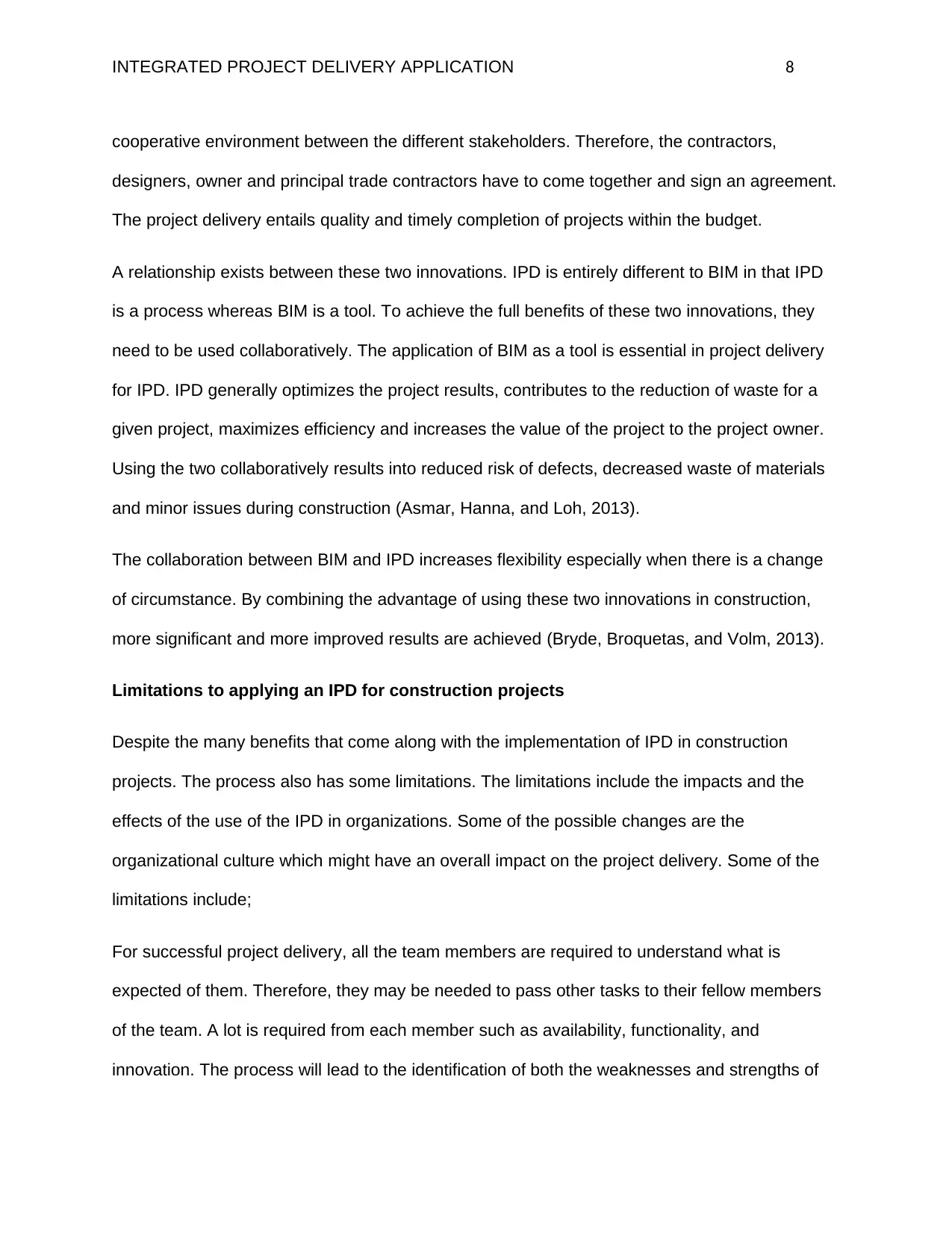
INTEGRATED PROJECT DELIVERY APPLICATION 8
cooperative environment between the different stakeholders. Therefore, the contractors,
designers, owner and principal trade contractors have to come together and sign an agreement.
The project delivery entails quality and timely completion of projects within the budget.
A relationship exists between these two innovations. IPD is entirely different to BIM in that IPD
is a process whereas BIM is a tool. To achieve the full benefits of these two innovations, they
need to be used collaboratively. The application of BIM as a tool is essential in project delivery
for IPD. IPD generally optimizes the project results, contributes to the reduction of waste for a
given project, maximizes efficiency and increases the value of the project to the project owner.
Using the two collaboratively results into reduced risk of defects, decreased waste of materials
and minor issues during construction (Asmar, Hanna, and Loh, 2013).
The collaboration between BIM and IPD increases flexibility especially when there is a change
of circumstance. By combining the advantage of using these two innovations in construction,
more significant and more improved results are achieved (Bryde, Broquetas, and Volm, 2013).
Limitations to applying an IPD for construction projects
Despite the many benefits that come along with the implementation of IPD in construction
projects. The process also has some limitations. The limitations include the impacts and the
effects of the use of the IPD in organizations. Some of the possible changes are the
organizational culture which might have an overall impact on the project delivery. Some of the
limitations include;
For successful project delivery, all the team members are required to understand what is
expected of them. Therefore, they may be needed to pass other tasks to their fellow members
of the team. A lot is required from each member such as availability, functionality, and
innovation. The process will lead to the identification of both the weaknesses and strengths of
cooperative environment between the different stakeholders. Therefore, the contractors,
designers, owner and principal trade contractors have to come together and sign an agreement.
The project delivery entails quality and timely completion of projects within the budget.
A relationship exists between these two innovations. IPD is entirely different to BIM in that IPD
is a process whereas BIM is a tool. To achieve the full benefits of these two innovations, they
need to be used collaboratively. The application of BIM as a tool is essential in project delivery
for IPD. IPD generally optimizes the project results, contributes to the reduction of waste for a
given project, maximizes efficiency and increases the value of the project to the project owner.
Using the two collaboratively results into reduced risk of defects, decreased waste of materials
and minor issues during construction (Asmar, Hanna, and Loh, 2013).
The collaboration between BIM and IPD increases flexibility especially when there is a change
of circumstance. By combining the advantage of using these two innovations in construction,
more significant and more improved results are achieved (Bryde, Broquetas, and Volm, 2013).
Limitations to applying an IPD for construction projects
Despite the many benefits that come along with the implementation of IPD in construction
projects. The process also has some limitations. The limitations include the impacts and the
effects of the use of the IPD in organizations. Some of the possible changes are the
organizational culture which might have an overall impact on the project delivery. Some of the
limitations include;
For successful project delivery, all the team members are required to understand what is
expected of them. Therefore, they may be needed to pass other tasks to their fellow members
of the team. A lot is required from each member such as availability, functionality, and
innovation. The process will lead to the identification of both the weaknesses and strengths of
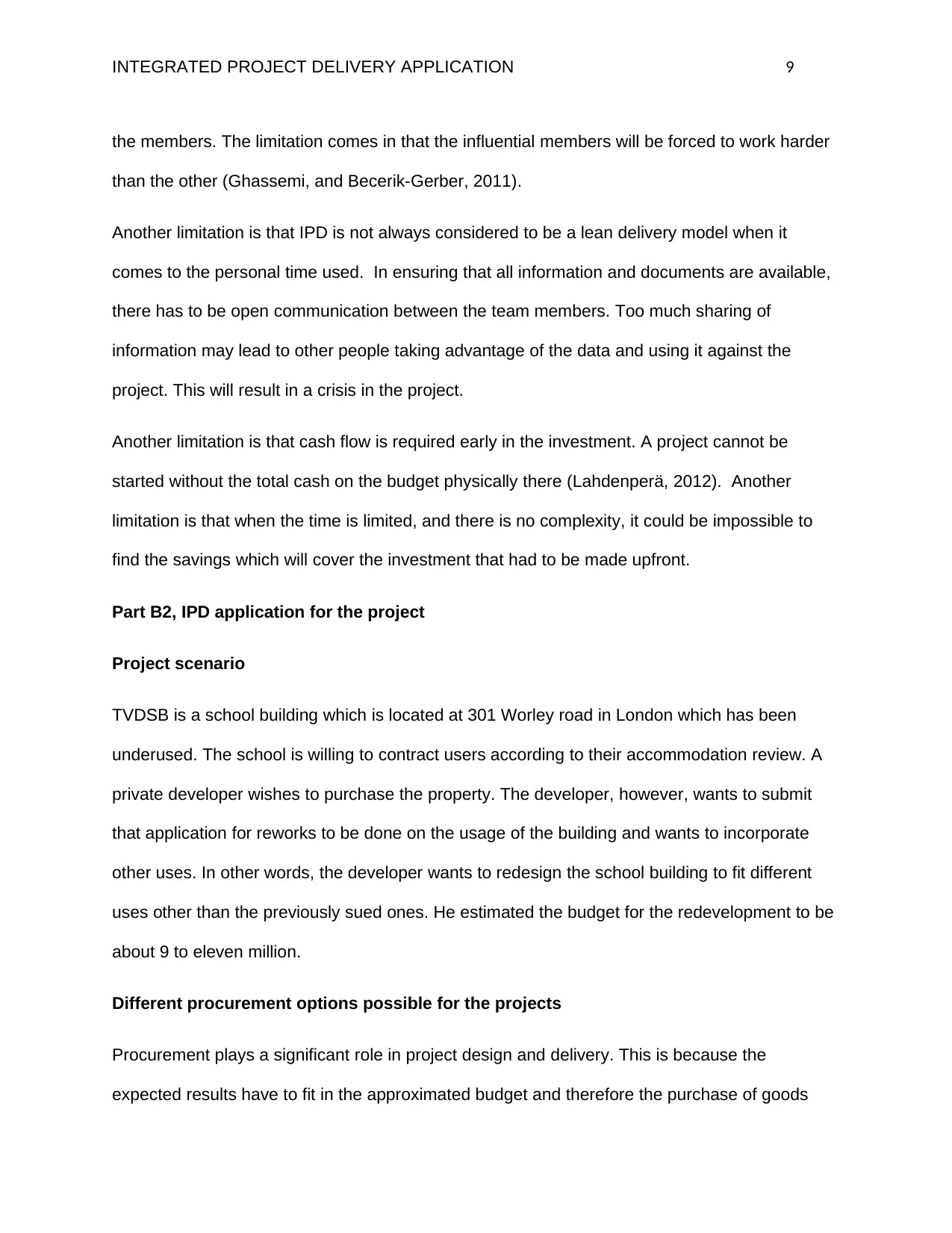
INTEGRATED PROJECT DELIVERY APPLICATION 9
the members. The limitation comes in that the influential members will be forced to work harder
than the other (Ghassemi, and Becerik-Gerber, 2011).
Another limitation is that IPD is not always considered to be a lean delivery model when it
comes to the personal time used. In ensuring that all information and documents are available,
there has to be open communication between the team members. Too much sharing of
information may lead to other people taking advantage of the data and using it against the
project. This will result in a crisis in the project.
Another limitation is that cash flow is required early in the investment. A project cannot be
started without the total cash on the budget physically there (Lahdenperä, 2012). Another
limitation is that when the time is limited, and there is no complexity, it could be impossible to
find the savings which will cover the investment that had to be made upfront.
Part B2, IPD application for the project
Project scenario
TVDSB is a school building which is located at 301 Worley road in London which has been
underused. The school is willing to contract users according to their accommodation review. A
private developer wishes to purchase the property. The developer, however, wants to submit
that application for reworks to be done on the usage of the building and wants to incorporate
other uses. In other words, the developer wants to redesign the school building to fit different
uses other than the previously sued ones. He estimated the budget for the redevelopment to be
about 9 to eleven million.
Different procurement options possible for the projects
Procurement plays a significant role in project design and delivery. This is because the
expected results have to fit in the approximated budget and therefore the purchase of goods
the members. The limitation comes in that the influential members will be forced to work harder
than the other (Ghassemi, and Becerik-Gerber, 2011).
Another limitation is that IPD is not always considered to be a lean delivery model when it
comes to the personal time used. In ensuring that all information and documents are available,
there has to be open communication between the team members. Too much sharing of
information may lead to other people taking advantage of the data and using it against the
project. This will result in a crisis in the project.
Another limitation is that cash flow is required early in the investment. A project cannot be
started without the total cash on the budget physically there (Lahdenperä, 2012). Another
limitation is that when the time is limited, and there is no complexity, it could be impossible to
find the savings which will cover the investment that had to be made upfront.
Part B2, IPD application for the project
Project scenario
TVDSB is a school building which is located at 301 Worley road in London which has been
underused. The school is willing to contract users according to their accommodation review. A
private developer wishes to purchase the property. The developer, however, wants to submit
that application for reworks to be done on the usage of the building and wants to incorporate
other uses. In other words, the developer wants to redesign the school building to fit different
uses other than the previously sued ones. He estimated the budget for the redevelopment to be
about 9 to eleven million.
Different procurement options possible for the projects
Procurement plays a significant role in project design and delivery. This is because the
expected results have to fit in the approximated budget and therefore the purchase of goods
⊘ This is a preview!⊘
Do you want full access?
Subscribe today to unlock all pages.

Trusted by 1+ million students worldwide
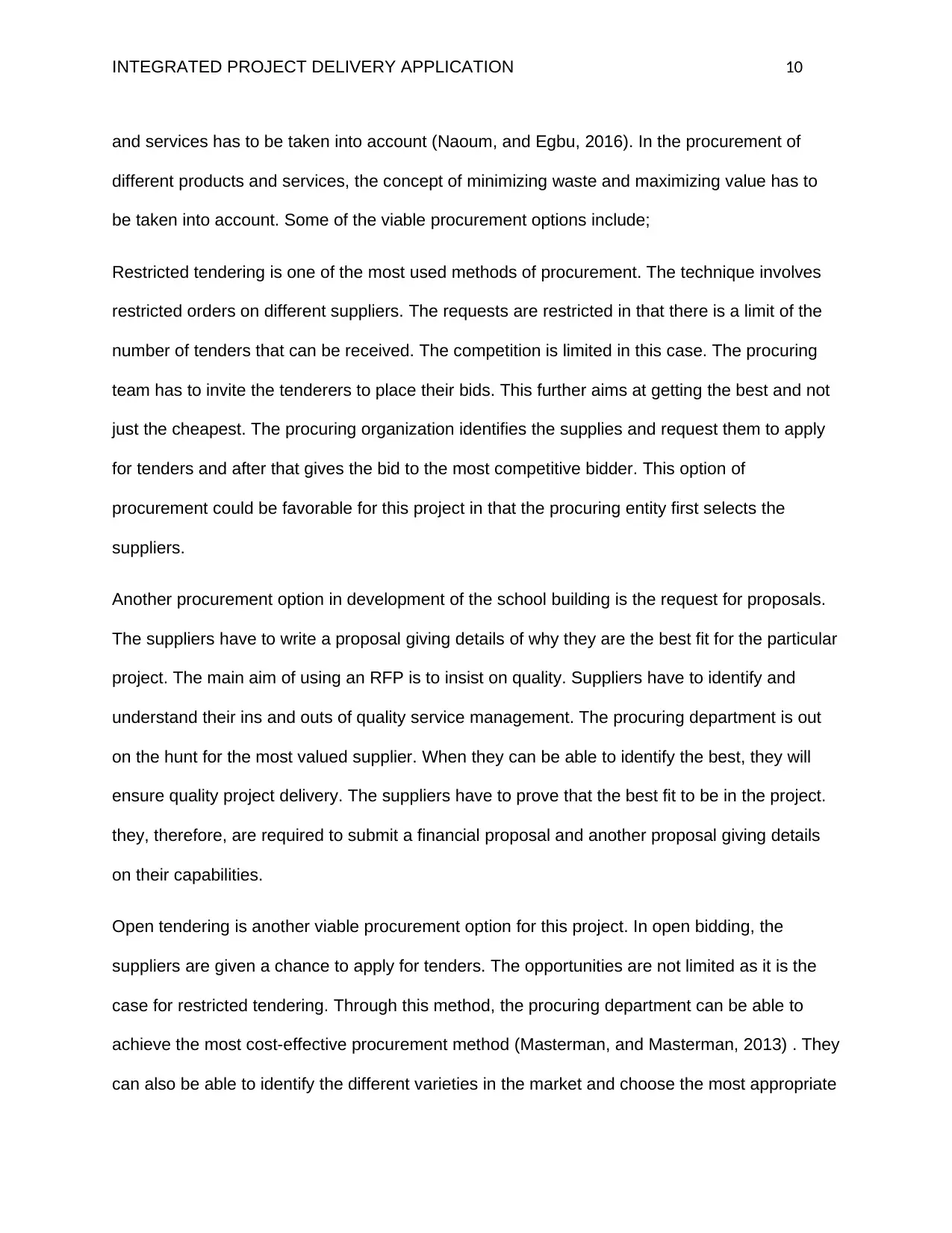
INTEGRATED PROJECT DELIVERY APPLICATION 10
and services has to be taken into account (Naoum, and Egbu, 2016). In the procurement of
different products and services, the concept of minimizing waste and maximizing value has to
be taken into account. Some of the viable procurement options include;
Restricted tendering is one of the most used methods of procurement. The technique involves
restricted orders on different suppliers. The requests are restricted in that there is a limit of the
number of tenders that can be received. The competition is limited in this case. The procuring
team has to invite the tenderers to place their bids. This further aims at getting the best and not
just the cheapest. The procuring organization identifies the supplies and request them to apply
for tenders and after that gives the bid to the most competitive bidder. This option of
procurement could be favorable for this project in that the procuring entity first selects the
suppliers.
Another procurement option in development of the school building is the request for proposals.
The suppliers have to write a proposal giving details of why they are the best fit for the particular
project. The main aim of using an RFP is to insist on quality. Suppliers have to identify and
understand their ins and outs of quality service management. The procuring department is out
on the hunt for the most valued supplier. When they can be able to identify the best, they will
ensure quality project delivery. The suppliers have to prove that the best fit to be in the project.
they, therefore, are required to submit a financial proposal and another proposal giving details
on their capabilities.
Open tendering is another viable procurement option for this project. In open bidding, the
suppliers are given a chance to apply for tenders. The opportunities are not limited as it is the
case for restricted tendering. Through this method, the procuring department can be able to
achieve the most cost-effective procurement method (Masterman, and Masterman, 2013) . They
can also be able to identify the different varieties in the market and choose the most appropriate
and services has to be taken into account (Naoum, and Egbu, 2016). In the procurement of
different products and services, the concept of minimizing waste and maximizing value has to
be taken into account. Some of the viable procurement options include;
Restricted tendering is one of the most used methods of procurement. The technique involves
restricted orders on different suppliers. The requests are restricted in that there is a limit of the
number of tenders that can be received. The competition is limited in this case. The procuring
team has to invite the tenderers to place their bids. This further aims at getting the best and not
just the cheapest. The procuring organization identifies the supplies and request them to apply
for tenders and after that gives the bid to the most competitive bidder. This option of
procurement could be favorable for this project in that the procuring entity first selects the
suppliers.
Another procurement option in development of the school building is the request for proposals.
The suppliers have to write a proposal giving details of why they are the best fit for the particular
project. The main aim of using an RFP is to insist on quality. Suppliers have to identify and
understand their ins and outs of quality service management. The procuring department is out
on the hunt for the most valued supplier. When they can be able to identify the best, they will
ensure quality project delivery. The suppliers have to prove that the best fit to be in the project.
they, therefore, are required to submit a financial proposal and another proposal giving details
on their capabilities.
Open tendering is another viable procurement option for this project. In open bidding, the
suppliers are given a chance to apply for tenders. The opportunities are not limited as it is the
case for restricted tendering. Through this method, the procuring department can be able to
achieve the most cost-effective procurement method (Masterman, and Masterman, 2013) . They
can also be able to identify the different varieties in the market and choose the most appropriate
Paraphrase This Document
Need a fresh take? Get an instant paraphrase of this document with our AI Paraphraser

INTEGRATED PROJECT DELIVERY APPLICATION 11
one. A significant disadvantage of using open tendering is that quality may not be assured and
the process takes a very long time, and this may reduce the productivity of the project delivery.
Strengths and weaknesses of the methods
Restricted tendering
Strengths
The procurement process takes lesser time compared to open Tendring
The procuring entity can be able to get the best
The already chosen tenderers are perceived to be able to provide quality
It is competitive compared to single sourcing; therefore, the cost is reduced
Weaknesses
The cost levels of tenders in restricted tendering are much higher compared to a method
like open Tendring. This is because the competition is low since the procuring entity
selects the tenderer
The process discourages and excludes small contractors that are trying to establish
themselves in the market. This reduces the chances of innovation in the construction
industry.
There is biasness involved. This is because firms may be excluded from the selected list
of tenderers for unknown reasons and other firms may be on the tenderers list for
unknown reasons too for example personal issues, and lack of awareness.
Request for proposals
Strengths
Use of this method can introduce the contractor to new suppliers, energy and ideas
one. A significant disadvantage of using open tendering is that quality may not be assured and
the process takes a very long time, and this may reduce the productivity of the project delivery.
Strengths and weaknesses of the methods
Restricted tendering
Strengths
The procurement process takes lesser time compared to open Tendring
The procuring entity can be able to get the best
The already chosen tenderers are perceived to be able to provide quality
It is competitive compared to single sourcing; therefore, the cost is reduced
Weaknesses
The cost levels of tenders in restricted tendering are much higher compared to a method
like open Tendring. This is because the competition is low since the procuring entity
selects the tenderer
The process discourages and excludes small contractors that are trying to establish
themselves in the market. This reduces the chances of innovation in the construction
industry.
There is biasness involved. This is because firms may be excluded from the selected list
of tenderers for unknown reasons and other firms may be on the tenderers list for
unknown reasons too for example personal issues, and lack of awareness.
Request for proposals
Strengths
Use of this method can introduce the contractor to new suppliers, energy and ideas

INTEGRATED PROJECT DELIVERY APPLICATION 12
The process ensures there is a fair selection and further provides the evidence
The vendors existing in the project will be given a chance t justify their services and
goods
The method provides a detailed vision of the timeline, the exact product and service
needed how to supply it.
There is a clearer picture of the prices, availability and the value of the resources.
Weaknesses
The process is bureaucratic thereby wasting a lot of time for the project
The method costs more since the procuring entity has to go with the best despite the
price charged.
The process involves a lot of paperwork which could be tedious
The formal screening process, meetings, and reviews do take up a lot of project time.
Open tendering
Strengths
There is high competition regarding prices; therefore, the procuring entity will have
reduced cost
The method gives the opportunity to new upcoming firms
There is no biasness as everyone is invited to apply
There are increased chances for innovation since new technology can be brought on
board.
Weakness
The project takes a lot of time for completion of the procurement procedure.
The process also requires that there be strict adherence to the procedures
The process ensures there is a fair selection and further provides the evidence
The vendors existing in the project will be given a chance t justify their services and
goods
The method provides a detailed vision of the timeline, the exact product and service
needed how to supply it.
There is a clearer picture of the prices, availability and the value of the resources.
Weaknesses
The process is bureaucratic thereby wasting a lot of time for the project
The method costs more since the procuring entity has to go with the best despite the
price charged.
The process involves a lot of paperwork which could be tedious
The formal screening process, meetings, and reviews do take up a lot of project time.
Open tendering
Strengths
There is high competition regarding prices; therefore, the procuring entity will have
reduced cost
The method gives the opportunity to new upcoming firms
There is no biasness as everyone is invited to apply
There are increased chances for innovation since new technology can be brought on
board.
Weakness
The project takes a lot of time for completion of the procurement procedure.
The process also requires that there be strict adherence to the procedures
⊘ This is a preview!⊘
Do you want full access?
Subscribe today to unlock all pages.

Trusted by 1+ million students worldwide
1 out of 20
Related Documents
Your All-in-One AI-Powered Toolkit for Academic Success.
+13062052269
info@desklib.com
Available 24*7 on WhatsApp / Email
![[object Object]](/_next/static/media/star-bottom.7253800d.svg)
Unlock your academic potential
Copyright © 2020–2025 A2Z Services. All Rights Reserved. Developed and managed by ZUCOL.





